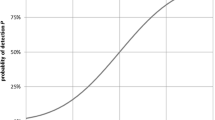Abstract
The energy spreading of recorded ions is influenced by straggling, geometrical acceptance angles and detector energy resolution effects in neutron depth profiling (NDP) and a symmetric Gaussian function model was customarily applied before. In addition, the spectra of mono-energetic alpha particles show a well known asymmetric shape as well when measured by silicon detectors. This article presents a physical model predicting the observed energy spectrum of a sample ion with target nuclides in prearranged depths. It is expressed as the convolution of a Gaussian function with a left-hand double-exponential function. Experiment showed that the predicted ions spectrum derived from the asymmetric model matches the observed energy spectrum. Therefore, the model can be applied to produce matrix for inversion of NDP spectrum.
Similar content being viewed by others

References
Ziegler J F, Cole G W, Baglin J E E. Technique for determining concentration profiles of boron impurities in substrates. J Appl Phys, 1972, 43(9):3809–3816
Downing R G, Lamaze G P, Langland J K, et al. Neutron depth profiling: Overview and description of NIST facilities. NIST J Res, 1993, 98(1):98–109
Tun Z, Noël J J, Bohdanowicz T, et al. Cold-neutron depth profiling as a research tool for the study of surface oxides on metals. Can J Phys, 2010, 88(10):751–758
Liu Y D, Yin Y H, Tan Y, et al. Research into tritium and helium-3 contents distributions in steel wall of spherical pressure vessel. Sci China Tech Sci, 2011, 54(6):1521–1524
Shultis J K. Notes on neutron depth profiling. Report 298, Engineering experiments station. College of Engineering Kansas State University, 2003
Steinbauer E, Bortels G. A survey of the physical processes which determine the response function of silicon detectors to alpha particles. Nucl Instrum Methods Phys Res, Sect A, 1994, 339:102–108
Ünlü K, Saglam M, Wehring B W, et al. Nondestructive determination of boron doses in semiconductor materials using neutron depth profiling. IEEE Proceedings of The Xi International Conference on Ion Implantation Technology, Austin, TX, 1997, 1(1):575–578
Ünlü K, Saglam M, Wehring B W. Helium-3 and boron-10 concentration and depth measurements in alloys and semiconductors using NDP. Nucl Instrum Methods Phys Res, Sect A, 1999, 422:885–890
L’Hoir A L. Study of the asymmetrical response of silicon surface barrier detectors to MeV light ions. Application to the precise analysis of light ions energy spectra. Nucl Instrum Methods Phys Res, Sect A, 1984, 223:336–345
Bortels G, Collaers P. Analytical function for fitting peaks in alpha-particle spectra from Si detectors. Appl Radiat Isot, 1987, 38(10):831–837
Coakley K J, Downing R G, Lamaze G P, et al. Modeling detector response for neutron depth profiling. Nucl Instrum Methods Phys Res A, 1995, 366(1):137–144
Maki J T, Ronald F F, Dietrich H V. Deconvolution of neutron depth profiling spectra. Nucl Instrum Methods Phys Res, Sect B, 1986, 17(2):147–155
Shultis J K. Computation and inversion of ion spectra for neutron depth profiling of curved surfaces. Nucl Instrum Methods Phys Res, Sect A, 2004, 526(3):359–375
Ziegler J F. Public domain computer code, SRIM-2000, IBM-Research/Yorktown. NY 10598, USA, 2001
Ziegler J F, Ziegler M D, Biersack J P. SRIM-The stopping and range of ions in matter. Nucl Instrum Methods Phys Res B, 2010, 268:1818–1823
Author information
Authors and Affiliations
Corresponding author
Rights and permissions
About this article
Cite this article
Dou, H., Li, R., Xu, J. et al. Modeling detector response function of alpha particles for neutron depth profiling. Sci. China Technol. Sci. 57, 35–38 (2014). https://doi.org/10.1007/s11431-013-5436-6
Received:
Accepted:
Published:
Issue Date:
DOI: https://doi.org/10.1007/s11431-013-5436-6



